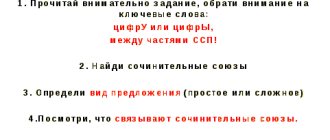In the Russian language there are various language parses, including punctuation. This article will help you understand what punctuation parsing is and what its specifics are, how to parse a sentence, and what the meaning of punctuation parsing is. The material can help in preparing for a Russian language lesson in middle school.
The material was prepared jointly with a teacher of the highest category
Kuchmina Nadezhda Vladimirovna.
Experience as a teacher of Russian language and literature - 27 years.
Meaning
Punctuation analysis of a sentence is a method for studying such a branch of linguistics as punctuation.
Punctuation and syntactic analysis should not be confused, since they pursue different goals: syntactic - to analyze the sentence, punctuation - to analyze punctuation marks.
Punctuation analysis helps to understand punctograms, their role and function in a sentence.
This type of analysis helps not only to correctly place punctuation marks, but also to explain the reasons for this setting.
When analyzing, it is necessary to justify not only the presence of punctuation marks, but also their absence where they can be mistakenly placed.
Punctuation analysis helps to consider individual parts of a sentence and their relationship with each other.
A certain order of punctuation analysis allows you to think consistently and systematically.
Since punctuation analysis is most often oral, it develops monologue speech.
The procedure for punctuation analysis of the text
Let's move on to the direct algorithm for punctuation parsing of sentences. It usually looks like this:
- Take a sentence as an example (or use one you wrote);
- Place numbers above all punctuation marks in the sentence;
- First of all, explain the punctogram (punctuation mark) at the end of the sentence. Since it depends on the emotional coloring of the sentence, as well as the purpose of its statement, determine what kind of sentence it is (narrative, incentive, interrogative, etc.);
- Decide on the structure and type of sentence - whether it is simple or complex;
- If the sentence is simple, name and explain the remaining points in the sentence;
- If the sentence is complex, name and explain the existing punctograms at the level of the complex sentence (i.e., punctuation marks between the existing parts of the complex sentence). Then name and explain the available punctograms in each part of the complex sentence.
Answers to these questions will help improve the quality of punctuation parsing of sentences
Structure
Punctuation analysis must be performed according to a specific plan:
- Number all punctuation marks.
- Explain the rule for placing or not placing a punctuation mark.
- Indicate the function that the punctuation mark performs.
The first point teaches you to see punctuation marks, the remaining points teach you to argue the reasons for placing or not placing a punctuation mark. This must be remembered before analyzing the proposal.
If there are several punctuation marks in a sentence that perform the same function, then they are grouped and explained once.
Examples of using punctuation analysis of written speech
Let's look at examples of punctuation analysis of simple and complex sentences.
Example of a simple sentence
As an example of a simple sentence, let's take the sentence:
“The words “language” and “speech” for a person who is not involved in linguistics usually mean the same thing.”
Let’s denote the punctograms in this sentence with numbers:
The words “language” and “speech” for a person (1) not involved in linguistics, (2) usually mean the same thing. (3)
Let's look at the proposal:
- The sentence is narrative, therefore there is a period at the end (3);
- The proposal is simple;
- Commas (1) and (2) are used in a separate definition. In this case, the separate definition of “not engaged in linguistics” is separated by commas, since it is expressed using a participial phrase, and comes after the word defined in the sentence (in this case, “person”).
The corresponding explanation from the Russian language textbook
Example of a complex sentence
As an example of a complex sentence, take the sentence:
“Of course, the modern Russian language is different from the one in which Pushkin, Gogol, Karamzin and Turgenev spoke and wrote.”
Let's designate each available paragraph in the sentence with numbers:
Of course, (1) the modern Russian language is different from the one (2) spoken and written by Pushkin, (3) Gogol, (4) Karamzin and Turgenev. (5).
Let's look at the proposal:
- First, we explain the punctogram at the end of the sentence. Since we are dealing with a declarative sentence where there is a complete thought, there should be a point (5) here.
- A comma (2) separates the subordinate part of a complex sentence from the main one;
- The comma (1) is used to separate the introductory word from the rest of the sentence;
- Commas (3) and (4) separate homogeneous members of the sentence.
Examples
For punctuation analysis, either sentences with inserted punctuation marks are used, or sentences into which you need to insert punctuation marks yourself and explain them.
He thought about (1) how wonderful everything is. (2)
1 – a comma separates parts of a complex sentence: subordinate clause and main clause.
2 – dot – a sign of completion at the end of a narrative sentence.
The sky (1) appears (2) purple. (3)
1, 2 – there are no commas, since “it seems” is a predicate and not an introductory word.
3 – dot – a sign of completion at the end of a narrative sentence.
The following example of punctuation analysis allows you to see the grouping of punctuation marks by function:
He saw (1) how the girl fed the pigeons, (2) who flocked to her, (3) how carefree it was on the street. (4)
1, 3 – commas separate parts of a complex sentence: subordinate clauses from the main one.
2, 3 – commas highlight a separate agreed common definition, expressed by a participial phrase.
4 – dot – a sign of completion at the end of a narrative sentence.
Punctuation analysis of a sentence
There are three interrelated types of sentence parsing:
Punctuation plays an important role in composing a statement, filling it with feelings and highlighting important points in the story.
The ability to correctly parse a sentence punctuationally is the key to literacy, since the likelihood of making a mistake in the placement of punctuation marks becomes minimal.
Punctuation analysis of a sentence is divided into several main actions:
- First of all, you need to determine the emotional content of the text, and to do this, check what punctuation mark the statement ends with. Hence, the sentence is exclamatory, interrogative or declarative;
- designate one or more grammatical bases, namely what main members the statement contains and how many of them. If there is a subject and a predicate, then this is a two-part sentence, if only one of them is present, then it is a one-part sentence. In addition, a sentence that is complex or simple in composition will become clear;
- schematically underline the subjects and predicates, and homogeneous members of the sentence, if any;
- assign numbers to punctuation marks and give reasons for each case of its absence or presence.
When the text contains direct speech, we first highlight the words of the author, then direct speech. The placement of punctuation marks depends on its location. If the hero’s words come before or after the author’s words, then 4 punctuation marks are needed to form direct speech. If the author's comments break the hero's text, then it will be 7.
Examples of performing punctuation parsing of a sentence:
- They listened to (1) the sound of the wind, (2) the sound of rain knocking on the roof, (3) the murmur of flowing down the pipes. (4)
(1) is a complex two-part sentence with two subordinate clauses (2).
(3) - participial phrase.
(4) – the sentence ends with a period, therefore, it is non-exclamatory and declarative in content.
- He looked into the stormy sky and thought (1) that a storm would soon begin. (2)
(1) – a complex sentence connected by the subordinating conjunction “what”. The first grammatical basis with homogeneous predicates connected by the conjunction “and” - “looked” and “thought” - in this case there is no comma.
(2) – the sentence ends with a period, therefore, it is non-exclamatory and declarative in content.
- Have you already seen a newborn (1), smiling at everyone around (2), sweetly pouting his lips (3), touchingly snuggling with his mother (4)?
(1) is a simple two-part sentence, since the grammatical basis is the same. Participial phrases are attached to it.
(2,3) – listing of phrases expressed by participial phrases.
(4) is an interrogative sentence, since the intonation and content suggest a question.
- She was attracted to everything about him: (1) appearance, (2) intelligence, (3) kindness, (4) decency, (5) love for children. (6)
(1) is a simple two-part sentence, where “everything attracted” is a general phrase followed by a list. That's why we put a colon here.
(2,3,4,5) – homogeneous complements connected by commas.
(6) – the sentence ends with a period, therefore, it is non-exclamatory and declarative in content.
- “(1) Let’s hurry up,” (2,3) said the teacher, “(4,5) because the lesson will end soon” (6).(7)
(1,6) – quotation marks that highlight direct speech in the text.
(2,3,4,5) – design of direct speech in the case when the author’s comments break the hero’s words.
(7) is a declarative non-exclamatory sentence, since there is a period at the end of the sentence.
The author's words are a simple two-part sentence.
The hero's text is a complex sentence with a causal conjunction “because”.
Symbols inside PP and SP
There can be many different punctuation symbols within a sentence. The main thing is to consider only the main, most common ones.
Using a dash
The dash “—” is used in sentences where one of the main syntactic members is missing. This sign replaces the missing word; it can be mentally filled in to understand the integrity of the picture. The dash is placed:
- As a separator, if the main members of a sentence form one independent unit of speech. It can be a noun in it. pad., infinitives, numerals.
- Separator of subject and predicate, provided that 1 is a verb in the indefinite form, 2 is a noun in the nominative case.
- If the sentence has a demonstrative pronoun: this, here. According to the rule, a dash is placed in front of it.
- Separator of the subject (noun) and predicate (cardinal number. In any setting.
Meaning of commas
Commas are often placed in unnecessary places. They are not used between homogeneous members related in meaning, and if they form an integral expression. Also in a situation where you can make the following schematic constructions:
- [Ο yes (= "and") Ο].
- [Ο and Ο].
In what cases is it necessary to use commas:
- If there is a listing of homogeneous words without allied elements.
- In the presence of opposing conjunctions. Commas are placed before them.
- After each repeated homogeneous member of the sentence.
- Between pair connections.
- If there are double alliances. A comma is placed before the second.
Semicolon
This sign ";" separates homogeneous members. Moreover, they should not be isolated words, but common ones, and have commas in the internal structure.
General word
Often there is one generalizing word before the listing of homogeneous words. In this case, commas, colons or dashes are used in one sentence. Sometimes both last signs at once. To understand the order of punctuation symbols, you can draw up a punctuation analysis diagram:
- [Θ: Ο, Ο, Ο].
- [Ο, Ο, Ο - Θ].
- [Ο, Ο, Ο, Ο, Ο - in a word, Θ].
- [Θ: and Ο, and Ο, and Ο - ...].
Direct speech
Sometimes it is necessary to indicate direct speech in the text. It has special spelling rules in Russian and is one of the most difficult topics to learn. The problem is that to correctly format direct speech you will need to use many types of punctuation: commas, colons, quotation marks, periods or other trailing symbols. The location in relation to the author’s text should also be taken into account:
- At first.
- At the end.
- In the center.
In addition, quotations have the same order of presentation as direct speech.
Basic terms and principles
Due to the wide variety of parsing (phonetic, lexical, morphemic, spelling, syntax, etc.), students often do not see the difference in some of them. Analyzes with similar content:
- Punctuation is the analysis of punctuation marks.
- Syntactic is the analysis of a separate semantic unit of a sentence. Mainly relies on major and minor members.
- Graphic - this analysis is needed in order to understand how the members of a sentence are related to each other, as well as the type and methods of expression.
It is important to understand that any of the branches of the science of language cannot exist separately from the others.
The plan for conducting punctuation analysis also depends on the interpretation of the task. Most often there are a couple of task options:
- Parse existing text with pre-arranged punctuation marks and ordinal numbers.
- Place the signs yourself and explain the reasons for such a statement.
When learning, problems arise in both cases.
In addition, they may be asked to create and draw a diagram. It will help detect common errors by identifying missing or, conversely, unnecessary characters.
When all theoretical aspects are taken into account, you can begin analysis. Punctuation analysis algorithm:
- Assign each punctuation element its own serial number.
- Explain the placement of the final sign at the end of a sentence.
- If the assignment contains a complex sentence (SP), then it is necessary to explain the punctuation elements between the main parts.
- If the sentence is simple (SP), then explain the placement of all the symbols inside it.
Punctuation at the end of a sentence
To explain this or that sign at the end, it is necessary to establish the type of statement. There are 4 classes in total:
- narrative;
- interrogative;
- exclamation;
- understatement.
Dot "." is placed in a declarative sentence, regardless of whether its construction is simple or complex. If an unsaid or incomplete thought is conveyed, then an ellipsis “…” is added. At the end of a question mark, a question mark “?” is indicated. When conveying an emotional sentence, use the exclamation symbol “!” . Sometimes punctuation marks are combined for greater effect:
- ? — !;
- ? — …;
- ! — …
This emotional method is mainly used in fiction: poetry, prose, novels and the like.


